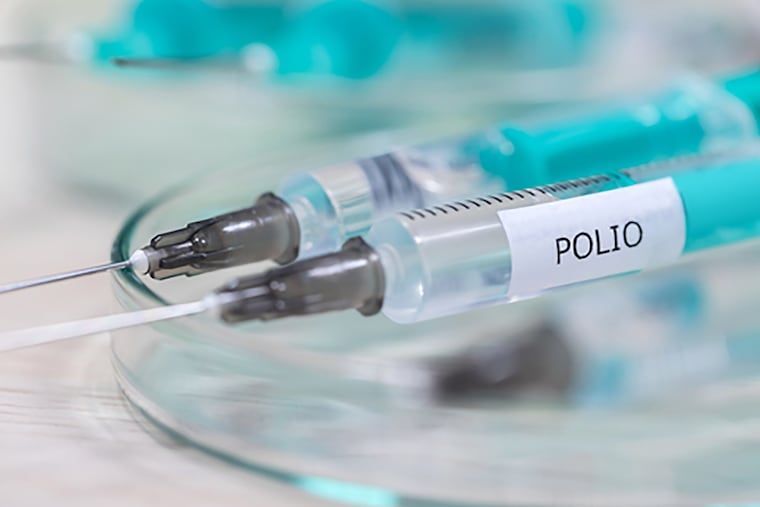As a new school year approaches, should Philadelphians be concerned about polio?
Local wastewater testing has yet to begin looking for polio, but health officials are urging parents to make sure kids' vaccinations are up to date.

Cases of polio in London, Israel, and closer to home in New York have health experts emphasizing the importance of vaccination against a virus that is exceedingly rare in the United States.
Philadelphia has not reported a polio case this summer, but city health officials are encouraging parents to get their children vaccinated before sending them to school next week.
Here’s what you need to know about polio in the United States, and what’s happening locally:
Why is polio so rare?
Polio was virtually eradicated in the United States with the introduction of a vaccine in 1955, which was widely adopted. The Centers for Disease Control and Prevention estimate that roughly 93% of children in this country are vaccinated against polio by their second birthday.
Prior to the vaccine, polio was among the most feared childhood diseases because it is highly contagious and caused about 15,000 cases of paralysis annually. That dropped to 10 a year by the 1970s.
Why are cases appearing now?
Injected doses of the vaccine have been favored in the United States since 2000, but the original oral form of the vaccine continues to be used worldwide.
The oral vaccine is more effective at preventing transmission, but it contains weakened virus that in rare cases can mutate into active polio that can infect others. Doctors believe that’s what happened in these recent cases.
Injected vaccine does not pose a risk of mutating into active polio. It contains inactive virus that cannot replicate, and so cannot mutate. Americans who are vaccinated are well-protected against polio.
Unvaccinated people are at risk.
How have cases been identified in the United States?
There has been one case of polio-related paralysis in the United States this summer, the first in about a decade. But wastewater testing in New York identified the virus that causes polio in wastewater from New York City, Orange County, and Rockland County, where the case of paralysis was reported. The young adult who developed paralysis had not been vaccinated against polio, the New York Times reported.
Wastewater testing has identified signs of the polio virus in samples from as far back as April in New York, the CDC reported, indicating there have probably been asymptomatic or unidentified polio cases in the state for months.
What are the symptoms of polio?
A majority of people infected with polio do not develop any symptoms. Some may experience flulike symptoms, such as sore throat, fever, fatigue, headache, and nausea, that resolve after two to five days, according to the CDC. Paralysis is a rare but serious complication of polio.
Is testing happening locally?
The Philadelphia Department of Public Health and Montgomery County, which both have wastewater testing programs, are not monitoring for polio at this time.
Both programs are funded with federal money that requires testing be used for COVID-19 surveillance, the health departments in Philadelphia and Montgomery County reported.
The city health department said testing for polio is being done under the purview of the CDC Polio Task Force.
» READ MORE: Philly’s been testing wastewater for COVID for months but isn’t using the data
Who’s at risk?
Anyone who isn’t vaccinated against polio is at risk of catching the virus.
Fortunately, most Americans are vaccinated against polio, and the vaccine is among those required by public schools. Pennsylvania data show 96.3% of schoolchildren in a sample of kindergartners, seventh graders, and high school seniors in the 2021-22 school year had received their polio vaccines.
Among sampled New Jersey children, almost 93% received all required vaccinations, including polio.
If vaccination rates are so high what’s the concern?
Vaccination rates among younger children are somewhat lower. Data from the New Jersey Department of Health showed 82% of children 2 or younger were up to date with their recommended vaccinations, including polio, as of 2020. In Philadelphia, 90% of children under 5 have received the full series of four vaccine doses, the city health department reported.
In Pennsylvania, just over 3% of students received either religious or philosophical exemptions from polio vaccination requirements.
Because of the pandemic, there was also a slight decrease in rates of children receiving routine vaccinations into 2021, according to the Philadelphia health department.
“Numbers rebounded, but we are still slightly lower than we were pre-pandemic,” said department spokesperson Matt Rankin.
The city health department keeps a database of children under 5 who have not received their full series of doses and is sending parents reminders urging them to vaccinate their children as soon as possible.
When should children be vaccinated?
The CDC recommends children receive doses of the polio vaccine at two months, four months, between 6 and 18 months, and at 4 to 6 years old.